Alliance for Open Media Releases Royalty-Free AV1 1.0 Codec Spec
by Anton Shilov on March 30, 2018 11:00 AM EST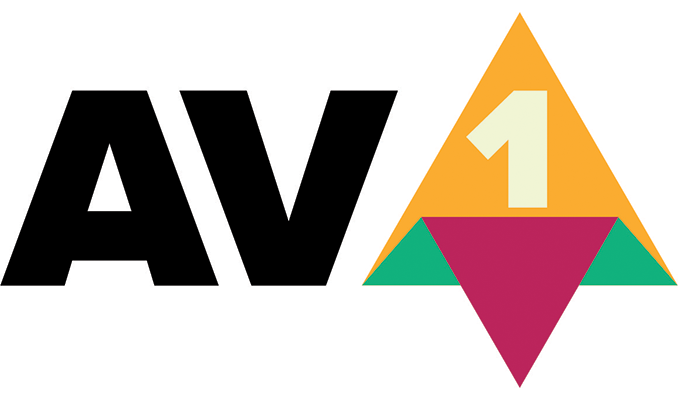
Eagerly awaited across the tech industry, this week the Alliance for Open Media (AOMedia) has published the first complete version of the bitstream and decoding process specification for their royalty-free AV1 video codec. The release of the AV1 1.0 spec will enable backers of AOMedia to add support for the technology to their products or services, including taking the all-important step of finalizing the designs for the low-power hardware decoders critical for driving the codec's adoption. At least initially, AV1 will be used primarily for streaming video and user-generated content as an alternative to HEVC and its ongoing royalty disputes, but eventually adoption of AV1 may expand to other applications.
The AV1 open-source video codec was developed with 4K+ ultra-high-def resolutions, HDR, and wide color gamut in mind. Among the key features the new codec, AOMedia mentions a 30% more efficient compression algorithm compared to existing methods, predictable requirements for computational capabilities of hardware, and maximum flexibility and scalability. The backers of the AV1 want the codec to be ubiquitous across devices and platforms, therefore expect it to be supported not only by major chipmakers, software designers, and service providers, but also by leading makers of consumer electronics.
AOMedia does not disclose key technological peculiarities of the AV1 video codec in a short whitepaper form, meanwhile parsing through a 600-page bitstream and decoding spec for developers does not necessarily help to explain all the peculiarities of the tech in general. Therefore, I am going to limit technical details about the AV1 to a necessary minimum here.
On a high level, the AV1 is conceptually similar to existing codecs, such as H.264 or H.265. AV1 uses the same basic elements as various codecs have used for well over a decade: block-based coding, variable block sizes (up to 128x128 pixels), block motion compensation, intra-frame compression, forward-integer transform and so on. Meanwhile, since we are talking about compression algorithms more efficient than existing ones, it is natural that the AV1 has a number of advantages over contemporary codecs.
The AV1 performs internal processing in 8, 10 or 12 bits per sample precision, it also supports all three widespread types of chroma subsampling (4:2:0, 4:2:2, 4:4:4), and virtually all major color gamuts and formats (sRGB, BT.2020 (both 10-bit and 12-bit), BT.2100, etc.). The BT.2020 and the BT.2100 recommendations include support not only for 3840×2160, but also for 7680×4320 (8K) resolution, so the AV1 is technically ready for the next-gen monitors and TVs.
| AV1 Profiles | |||||
| seq_profile | Bit Depth | sRGB Gamut Support | Chroma Subsampling | ||
| 0 | 8 or 10 | No | YUV 4:2:0 | ||
| 1 | 8 or 10 | Yes | YUV 4:4:4 | ||
| 2 | 8 or 10 | No | YUV 4:2:2 | ||
| 2 | 12 | Yes | YUV 4:2:0 YUV 4:2:2 YUV 4:4:4 |
||
Speaking of displays, it is necessary to note that the AV1 was designed to be compatible with existing interconnections, such as DisplayPort, eDP, HDMI and so on. That said, the technology should also be compatible with contemporary content protection technologies.
The publication of the AV1 spec 1.0 is merely the first step towards adoption of the technology by the market. AOMedia expects content creation tools and desktop browsers to begin to roll out support for AV1 later this year. To ensure this, AOMedia released an unoptimized/experimental AV1 software decoder and encoder for use in software applications. Then, sometimes in 2019, the consortium anticipates select chips and programs to support the tech. More widespread support of the AV1 along with adoption by software is projected for 2020.
Speaking of adoption, the list of AOMedia members includes a variety of influential companies, including Apple, Amazon, AMD, Arm, Broadcom, Facebook, Google, Hulu, Intel, IBM, Microsoft, Netflix, NVIDIA, Realtek, Sigma and many others. These companies either control huge ecosystems themselves, or develop chips that are used by hundreds of millions of customers worldwide. Their support will ensure widespread adoption of the AV1 in the next decade. In the meantime, AOMedia has already started R&D for the AV2, which is to succeed the AV1 codec.
Related Reading:
Source: AOMedia


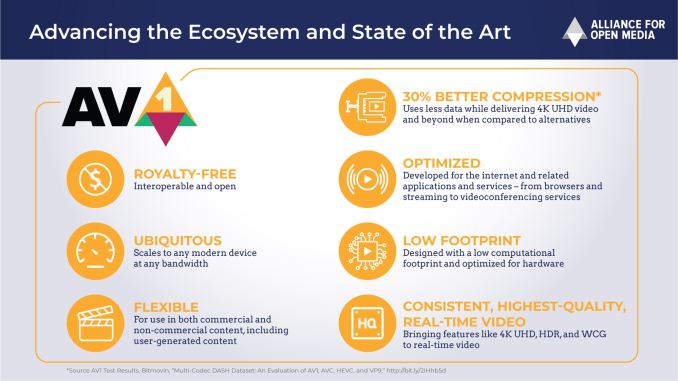
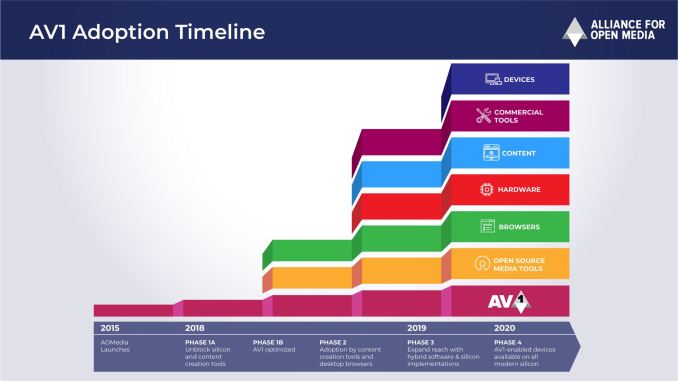
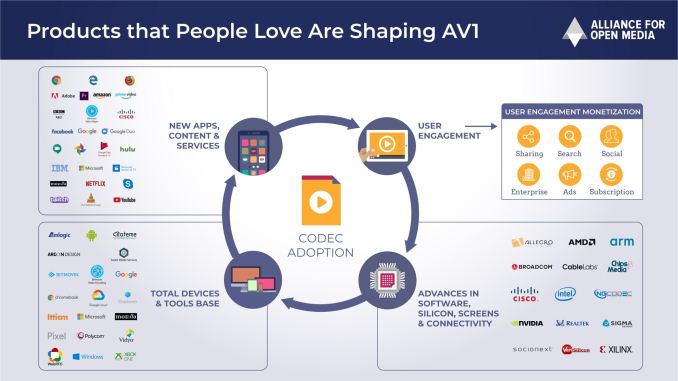
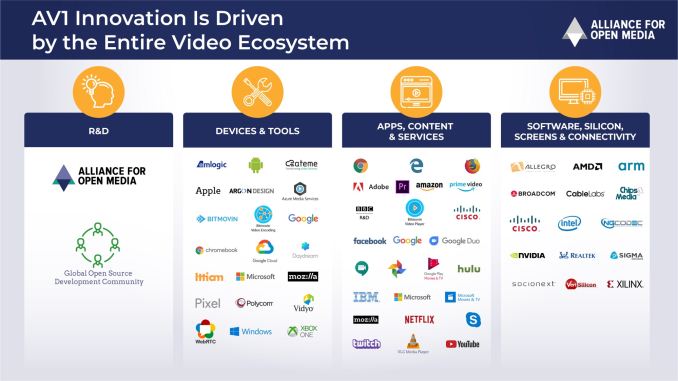













71 Comments
View All Comments
ZeDestructor - Monday, April 2, 2018 - link
*ahem*"GM206’s decoder was a major upgrade from GM204’s. Importantly, it added full HEVC fixed function decoding. And not just for standard 8bit Main Profile HEVC, but 10bit Main10 Profile support as well"
Source: https://www.anandtech.com/show/10325/the-nvidia-ge... around middle of page
ZolaIII - Tuesday, April 3, 2018 - link
Ah found a parent ask.ZeDestructor - Tuesday, April 3, 2018 - link
Yeah, I found the tobacco store :PZolaIII - Tuesday, April 3, 2018 - link
Coffee shop with green bites would had been even better. :')SydneyBlue120d - Saturday, March 31, 2018 - link
You're technically correct, however I'd like to remember You there is at least one mobile maker supporting the new codec, is name is Apple.levizx - Tuesday, February 11, 2020 - link
2 years later. Both Apple and Samsung joined AOMedia, MTK actually launched the very first AV1-enabled mobile SOC.Elstar - Friday, March 30, 2018 - link
I wonder if "this time will be different". People always complains about MPEG royalties during standards transitions, but once the next standard is embraced, the complaining subsides.The "problem" is that hardware manufactures don't want to implement multiple encoders/decoders, so MPEG tends to win due to the investment costs.
iter - Friday, March 30, 2018 - link
The reference implementation is most likely very basic and slow. Even if it is an open standard and free to license, good hardware accelerated implementations will not be necessarily free or open source.The one thing that nobody on this planet should doubt is the ability of the industry to ruin even the best of things.
If they had their way, they'd be happy to sell us breathing air. And pretty soon might do just that.
tuxRoller - Friday, March 30, 2018 - link
This time is different BECAUSE they developers of the codec are working hand-in-hand with the hardware companies. There's been a standing meeting (iirc, every quarter) where key software codec folks go to Taiwan for full syncs with all stake holders. As a result they've even had to drop some of the experiments because the hardware folks said they were too costly to implement. Hopefully we'll see these used in av2 since they are quite innovative (a good bit is from daala, which had a radicallyElstar - Friday, March 30, 2018 - link
If you look at the list of AV1 companies, the list *missing* hardware players list is very telling. AV1 clearly doesn't have the support of the professional or semi-professional video hardware community. AV1 might still succeed in spite of this. After all, the video recording device business is dwarfed by smartphones these days. I suspect in the end we'll have two standards on all of devices instead of two. Hurray for "progress".